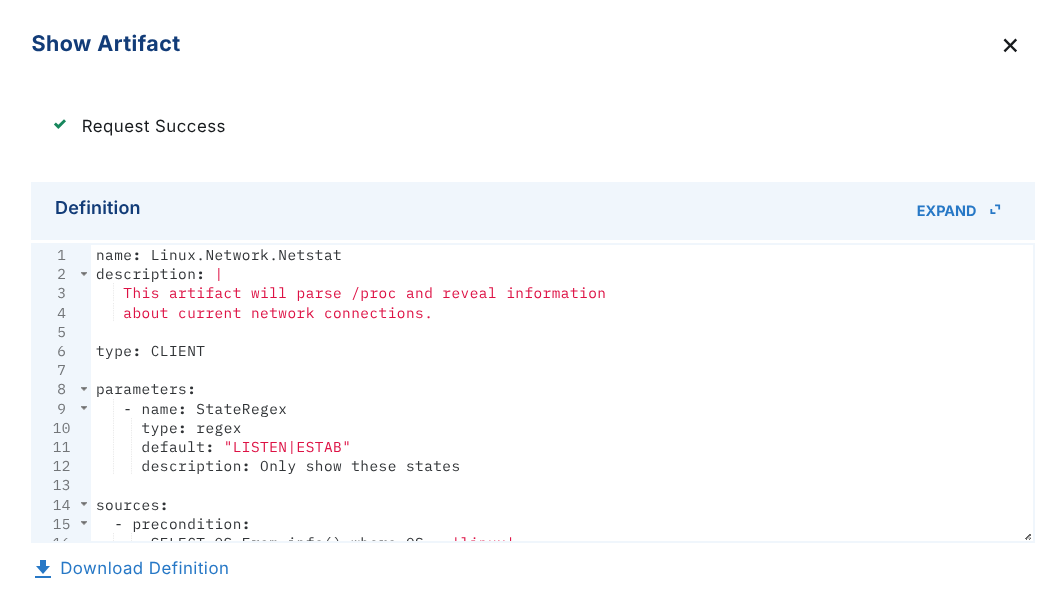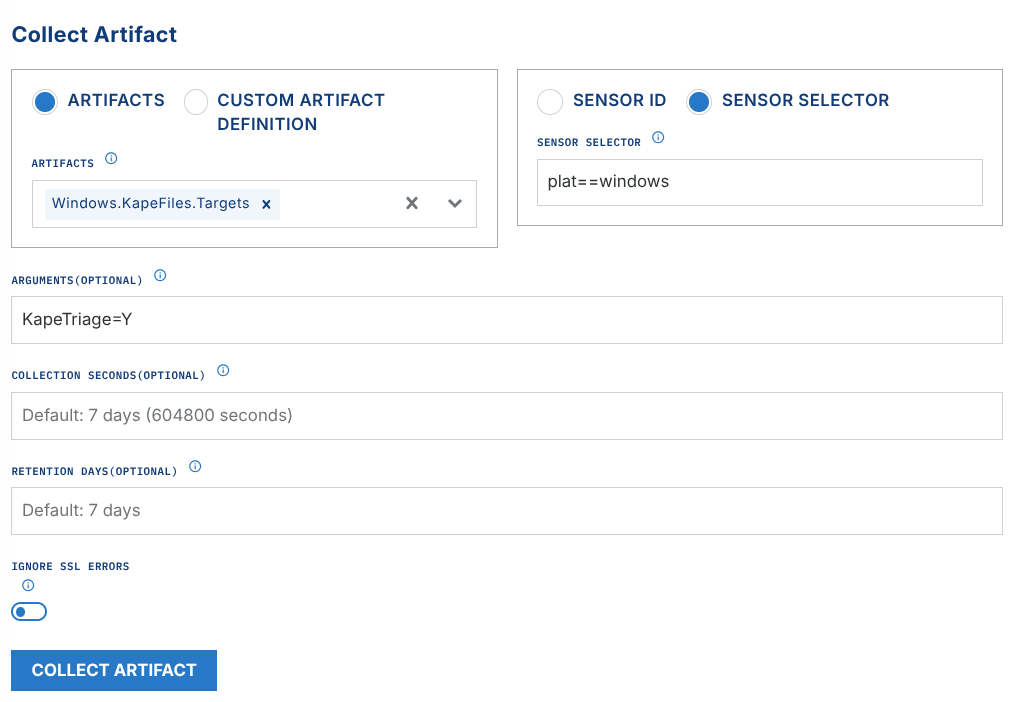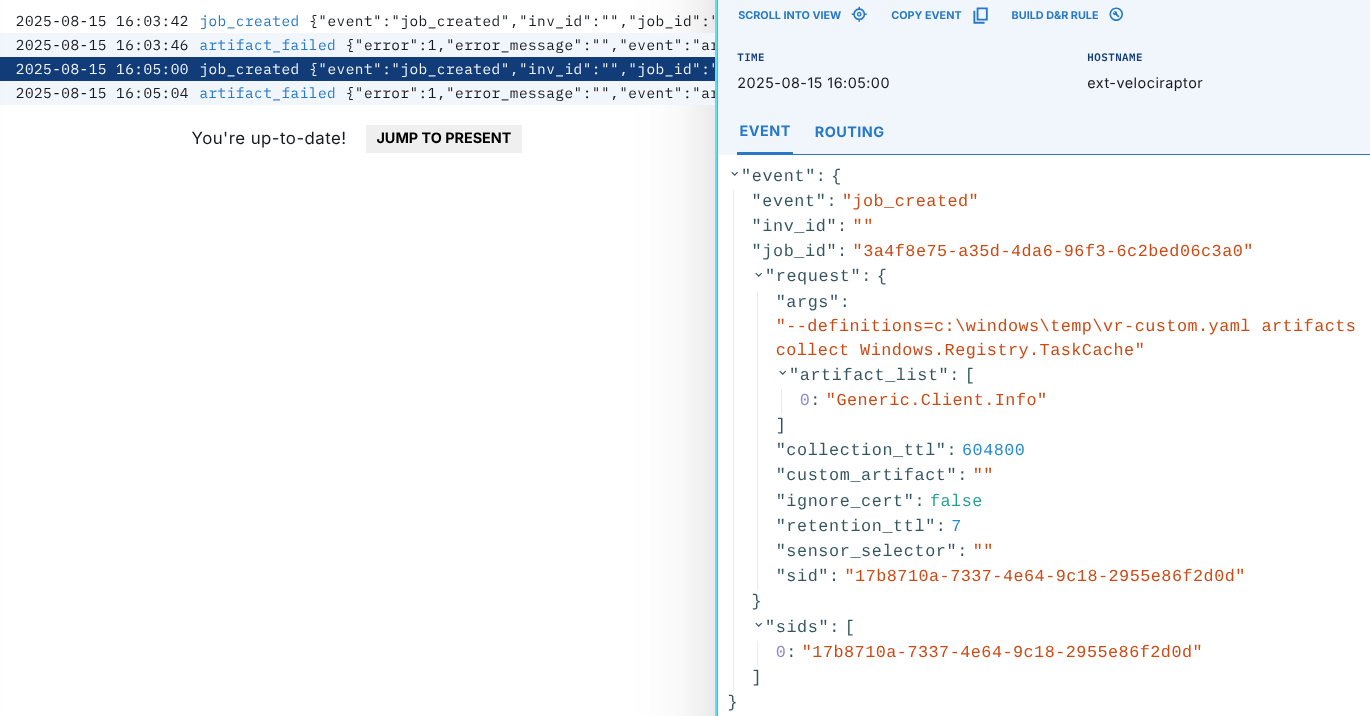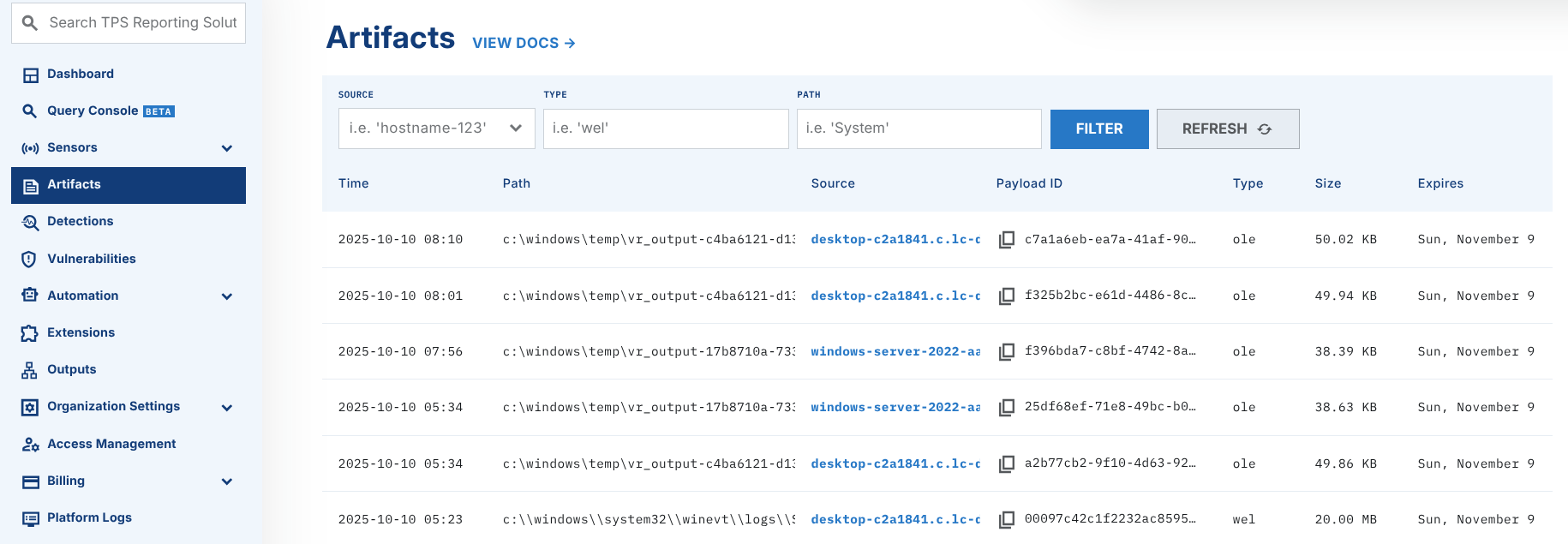- 10 Oct 2025
- 4 Minutes to read
- Print
- DarkLight
Velociraptor
- Updated on 10 Oct 2025
- 4 Minutes to read
- Print
- DarkLight
Overview
Velociraptor is an open source endpoint visibility tool that includes power digital forensic, incident response, and incident triage capabilities. LimaCharlie can be used to deploy Velociraptor at scale, allowing for easy artifact collection and incident analysis.
The interface defines 2 main actions:
Show Artifact - allows you to inspect the VQL artifacts available for collection
Collect Artifact - allows you to run an artifact collection on one or more endpoints
Show Artifact
Simply choose an artifact from the list to inspect it's contents.

Result of the action

Collect Artifact
This allows you to collect one or more Velociraptor Artifacts from one or more endpoints via the Endpoint Agent.
Velociraptor will generate a ZIP file with all collected data, which is automatically ingested into LimaCharlie's Artifact system for download.
Arguments
Artifacts - Select one or more Velociraptor artifacts you wish to collect
Sensor Selector - Select either a single sensor by selecting it's Sensor ID from the dropdown or use a Sensor Selector Expression to cast a wider net such as
plat==windowsArguments (optional) - These are optional arguments (or parameters) passed directly to the Velociraptor Artifact. For instance, if you wanted to run a collection for Windows.KapeFiles.Targets and wanted to specify the KapeTriage targets for collection, you would specify
KapeTriage=Yin the Arguments since this is a boolean parameter for theWindows.KapeFiles.Targetsartifact.Collection Seconds (optional) - Define how long (in seconds) the Extension will wait for a targeted endpoint to come online and be processed for collection.
Retention Days (optional) - Define how long the collected artifact will be retained by the platform.
Ignore SSL Errors (optional) - Tells the endpoint to ignore SSL errors while running and collecting. This can be useful if the endpoint is behind a MITM proxy or firewall performing SSL interception.
Monitoring Collections
You are able to track Velociraptor hunts by viewing the Timeline for the ext-velociraptor sensor.

Once you see artifact_uploaded in the timeline, you can expect to find the artifact on the "Artifacts" screen.

Automating Collection Retrieval
Let's say you wanted to automatically fetch new Velociraptor collections and send somewhere else for storage/processing. This can be accomplished via rules which watch for the artifact upload and send to a tailored output.
Example D&R rule
# Detection
op: is
path: routing/log_type
target: artifact_event
value: velociraptor
# Response
- action: output
name: artifacts-tailored
suppression:
is_global: false
keys:
- '{{ .event.original_path }}'
- '{{ .routing.log_id }}'
max_count: 1
period: 1m
- action: report
name: VR artifact ingested
To see how you could use something like this to automate post-processing of Velociraptor triage collections, check out this open source example which sends KAPE Triage acquisitions to a webhook which then retrieves the collection for processing via Plaso and into Timesketch.
To see how you can send Velociraptor data to BigQuery for further analysis, see this tutorial.
Using Velociraptor in D&R Rules
If you want to trigger a Velociraptor collection as a response to one of your detections, you can configure an extension request in the respond block of a rule.
This example will kick off the KAPE files Velociraptor artifact to collect event logs from the system involved in the detection.
- action: extension request
extension action: collect
extension name: ext-velociraptor
extension request:
artifact_list: ['Windows.KapeFiles.Targets']
sid: '{{ .routing.sid }}' # Use a sensor selector OR a sid, **not both**
sensor_selector: '' # Use a sensor selector OR a sid, **not both**
args: '{{ "EventLogs=Y" }}'
collection_ttl: 3600 # 1 hour - collection_ttl is specified in seconds
retention_ttl: 7 # retention_ttl is specified in days
ignore_cert: false
Migrating D&R Rule from legacy Service to new Extension
LimaCharlie is migrating away from Services to a new capability called Extensions. Support of legacy services will end on June 30, 2024.
The Python CLI gives you a direct way to assess if any rules reference legacy Velociraptor service, preview the change and execute the conversion required in the rule "response".
Command line to preview Velociraptor rule conversion:
limacharlie extension convert_rules --name ext-velociraptor
A dry-run response (default) will display the rule name being changed, a JSON of the service request rule and a JSON of the incoming extension request change.
To execute the change in the rule, explicitly set --dry-run flag to --no-dry-run
Command line to execute Velociraptor rule conversion:
limacharlie extension convert_rules --name ext-velociraptor --no-dry-run

